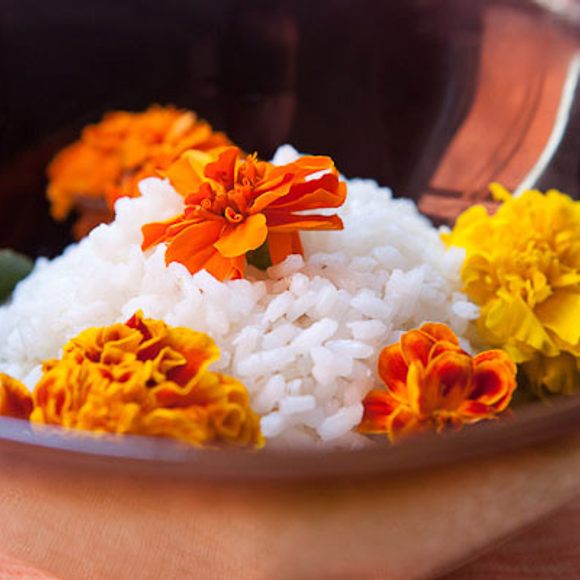Ingredients & Condiments
Carolina Gold
This varietal of rice is so good that it's compared to ice cream.
Before the Civil War, rice was, if not king, at least one of the most profitable crops in South Carolina. One variety of rice in particular drew global accolades—Carolina Gold, a type of rice that was likely brought from West Africa and planted by enslaved people from Africa’s “Rice Coast.” Carolina Gold was exported to the wealthy around the world and made Charleston, which exported millions of tons of rice a year, a rich city.
A few things set Carolina Gold apart. The first is the rich gold color of the mature rice plant and the unhulled grain. When the sun shines on a field of Carolina Gold, it creates a bright, visible aura. The nutty flavor is also special. When Carolina Gold is boiled with herbs and then baked, the dish is called “Charleston Ice Cream,” as an ode to its refined taste and delicate texture. Depending on how it is prepared and cooked, Carolina Gold can be either sticky or fluffy, making it suitable for everything from pudding to pilaf.
One quality of Carolina Gold was a double-edged sword for those who produced it. All rice in antebellum South Carolina was laboriously harvested and processed by enslaved people. Due to its fragility, only 70 percent of Carolina Gold Rice remained intact enough to ship, and whole grains had to be hand-sorted.
This delicacy, along with Carolina Gold’s fine flavor, made it a prized commodity among elite Americans and Europeans. But the backbreaking production process made Carolina Gold cultivation unsustainable without slavery. After the Civil War, emancipation led to its decline, along with factors such as the wartime destruction of rice plantations and an inability to compete with mechanization. As rice production industrialized, Carolina Gold faded from the fields.
In the 1980s, an eye surgeon in South Carolina, Dr. Richard Schulze, became interested in the vintage crop. He discovered that a seed bank in Texas had saved a sample of Carolina Gold. With 14 pounds of seed, Schulze and his wife Patricia planted their property with the grain. They soon produced the first commercial crop of Carolina Gold since 1927. While Carolina Gold previously could not compete with cheap, mass-produced rice, it has found new life in an era of foodies willing to pay for unique, flavorful foods. The restored rice has proved popular with restaurateurs, and in 1988, the Carolina Gold Rice Foundation was established to promote its restoration, as well as that of other lost grains.
Written By
 Anne Ewbank
Anne Ewbank
Sources
- news.nationalgeographic.com/news/2007/11/071128-rice-origins.html
- savannahnow.com/accent/2015-04-25/retired-savannah-eye-surgeon-credited-return-beloved-lowcountry-rice
- www.nytimes.com/1988/12/28/garden/carolina-gold-a-rare-harvest.html#
- www.slowfoodusa.org/ark-item/carolina-gold-rice
- www.bbc.com/travel/story/20160328-is-this-the-worlds-greatest-rice
















